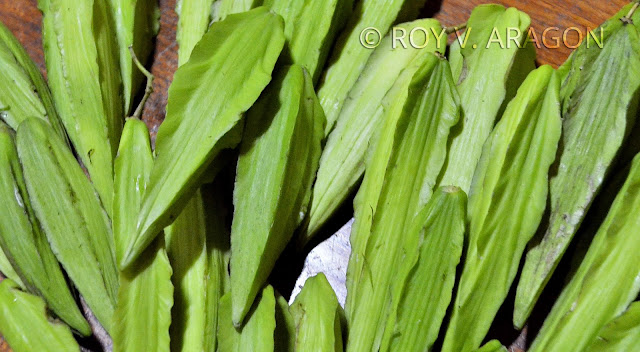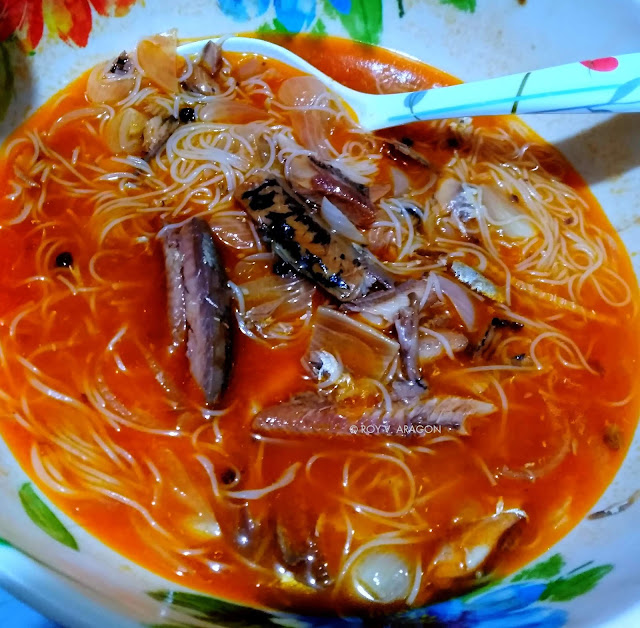It's rather unusual for some, even to the most self-professedly G.I. or "patneng nga Ilokano" (so-called true blue, "native" Ilokano), to find a dinengdeng like this, some of the Ilokanos in our rural home and place of the heart and hearth so to speak, in Casantolan. I mean this particular way that the fruit stalk or stem of the aubergine (well, that's tarong commonly called eggplant but here, these are not even egg-shaped so I call it aubergine; I refuse to call it brinjal--to be more Asian, but it may all the more confuse people) is not removed and isn't kind of awkward?
Well, with the pamurosan (fruit stalk or stem) not removed, these are small and yet tender and young tarong fruit and at this stage of the fruit, the stalk/stem is edible and tender and so you can eat it together with the fruit. It also serves as a ready handle if you prefer to eat with your hands or if you pick your food, your sida (ulam, viand) with your hands when you eat (just like me, at times).
Yes, it's there because it's edible and because this is yet again an Ilokano way (just a way, not a show of) of that branded and patented virtue of kirmet-ness a.k.a. thriftiness, the frugality (economic at that) of the Ilokano not to waste sources and resources, and all that blah blahs about Ilokano-ness and stuff. But well, it's a personal preference. I love this and I'm used to it. And when I'm in Casantolan, I pick the more immature fruits of the tarong plant and leave the pamurosan intact when I make a dinengdeng. The stalk has a distinct sweetish flavor.
This is a simple dinengdeng of the "stalked" aubergine, and parda, and patani, with a lucky sagpaw (add-on) of grilled tilapia:
As you can see, the dinengdeng is kind of dry, you can't see lots of digo (broth, soup) in there. I cooked it pinakbet-like. But this is still a dinengdeng. An almost dry dinengdeng is very good, the bugguong all the more suffused with the veggie goodness and it has only a sauce-like thickened broth for digo which is just perfect for your innapuy (steamed rice).
And yes, we do the same with the pinakbet, here are "stalked" tarong in two of my recent pinakbets:
Now, I wonder if you do the same. Tell me.
Well, with the pamurosan (fruit stalk or stem) not removed, these are small and yet tender and young tarong fruit and at this stage of the fruit, the stalk/stem is edible and tender and so you can eat it together with the fruit. It also serves as a ready handle if you prefer to eat with your hands or if you pick your food, your sida (ulam, viand) with your hands when you eat (just like me, at times).
Yes, it's there because it's edible and because this is yet again an Ilokano way (just a way, not a show of) of that branded and patented virtue of kirmet-ness a.k.a. thriftiness, the frugality (economic at that) of the Ilokano not to waste sources and resources, and all that blah blahs about Ilokano-ness and stuff. But well, it's a personal preference. I love this and I'm used to it. And when I'm in Casantolan, I pick the more immature fruits of the tarong plant and leave the pamurosan intact when I make a dinengdeng. The stalk has a distinct sweetish flavor.
This is a simple dinengdeng of the "stalked" aubergine, and parda, and patani, with a lucky sagpaw (add-on) of grilled tilapia:
As you can see, the dinengdeng is kind of dry, you can't see lots of digo (broth, soup) in there. I cooked it pinakbet-like. But this is still a dinengdeng. An almost dry dinengdeng is very good, the bugguong all the more suffused with the veggie goodness and it has only a sauce-like thickened broth for digo which is just perfect for your innapuy (steamed rice).
And yes, we do the same with the pinakbet, here are "stalked" tarong in two of my recent pinakbets:
Now, I wonder if you do the same. Tell me.
:::::






































































